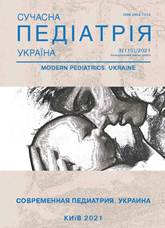Gilbert's syndrome in a newborn (a clinical case)
DOI:
https://doi.org/10.15574/SP.2021.115.79Keywords:
Gilbert's syndrome, hyperbilirubinemia, a newbornAbstract
Purpose — to demonstrate the features of the course and treatment of Gilbert's syndrome in a newborn.
Materials and methods. We present A clinical case of follow-up of a newborn with Gilbert's syndrome. The paper examines the features of the course and treatment of this disease.
Results. Important is the fact that the difficulties in diagnosing Gilbert's syndrome in newborns are primarily due to current problems in neonatology, namely the diagnostics of pigmentary disorders that occur during bilirubin metabolism. The polymorphism of Gilbert's syndrome symptoms and the lack of a clear association with plasma bilirubin levels make it difficult to diagnose the disease, especially in newborns. The peculiarity of the course of Gilbert's syndrome in the given case is as follows: early onset of the disease (from the day of birth), the presence of high hyperbilirubinemia (total bilirubin — 189.2 μmol/l, direct bilirubin — 24.3 μmol/l, indirect bilirubin — 164.9 μmol/l), intermittent attacks of jaundice. The severity of the disease is also due to the transient condition of the newborn: hypoxic and ischemic lesions of the CNS, transient dysfunction of the adrenal cortex, open oval window, and the mother's failure to follow clear principles of treatment of Gilbert's syndrome in breastfed infants.
Conclusions. The peculiarity of this disease is the fact that the mother is at risk of giving birth to a sick child due to a burdened hereditary history of the paternal line (Gilbert's syndrome). Therefore, it is necessary to provide medical and genetic counseling when planning the birth of a child to determine the degree of risk of birth with this disease.
The research was carried out in accordance with the principles of the Helsinki Declaration. The informed consent of the patient was obtained for conducting the studies.
No conflict of interest was declared by the authors.
References
Ehmer U, Kalthoff S, Fakundiny B. (2012). Gilbert syndrome redefined: a complex genetic haplotype influences the regulation of glucuronidation. Hepatology. 55 (6): 1912-1921. https://doi.org/10.1002/hep.25561; PMid:22213127
Gusev VD, Avdil A, Vladimirova ES, Ajdarova BD, Zhetpisova AZH. (2015). Trudnosti diagnostiki sindroma Zhil'bera u novorozhdennykh. Medicina I ehkologiya. 1: 15-22.
Ismail AQ, Gandhi A, El-Shimy N. (2011). Intractable neonatal jaundice due to hereditary spherocytosis and Gilbert's syndrome. BMJ Case Rep. 34: 16-25. https://doi.org/10.1136/bcr.05.2011.4293; PMid:22689841 PMCid:PMC3149415
Riabushko OB. (2020). Eponimichni terminy v medychnii henetytsi. Aktualni problemy suchasnoi medytsyny: visnyk Ukrainskoi medychnoi stomatolohichnoi akademii. 20; 4 (72): 237-240.
Saki F, Hemmati F, Haghighat M. (2011). Prevalence of Gilbert syndrome in parents of neonates with pathologic indirect hyperbilirubinemia. Ann. Saudi. Med. 31 (2): 140-144. https://doi.org/10.5144/0256-4947.2011.140; PMid:21403409 PMCid:PMC3102472
Skryipnik IN, Maslova AS. (2012). Dobrokachestvennyie giperbilirubinemii. Novosti meditsinyi i farmatsii (gastroenterologiyya): 419. URL: http://www.mif-ua.com/m/archive/article/32971.
Sorokman TV, Popeliuk OMV, Makarova OV. (2016). Syndrom Zhylbera: terminolohiia, epidemiolohiia, henetyka, patohenez (chastyna I). Zdorov'e rebenka. 8 (76): 82-86. https://doi.org/10.22141/2224-0551.8.76.2016.90830
Sorokman TV, Popeliuk OMV, Makarova OV. (2017). Syndrom Zhylbera: klinika, diahnostyka, dyferentsiina diahnostyka ta likuvannia. Zdorov'e rebenka. 12 (1): 41-48. https://doi.org/10.22141/2224-0551.12.1.2017.95025
Varlamova OS. (2016). Viral hepatitis A and Gilbert's syndrome. Conference on Hepatitis: modern views on the issuе: Kiev.
Zaja O, Tiljak MK, Stefanovic M. (2014). Correlation of UGT1A1 TATA-box polymorphism and jaundice in breastfed newborns - early presentation of Gilbert's syndrome. J Matern Fetal Neonatal Med. 27 (8): 844-850. https://doi.org/10.3109/14767058.2013.837879; PMid:23981182
Downloads
Published
Issue
Section
License
Copyright (c) 2021 Modern Pediatrics. Ukraine

This work is licensed under a Creative Commons Attribution-NonCommercial 4.0 International License.
The policy of the Journal “MODERN PEDIATRICS. UKRAINE” is compatible with the vast majority of funders' of open access and self-archiving policies. The journal provides immediate open access route being convinced that everyone – not only scientists - can benefit from research results, and publishes articles exclusively under open access distribution, with a Creative Commons Attribution-Noncommercial 4.0 international license (СС BY-NC).
Authors transfer the copyright to the Journal “MODERN PEDIATRICS. UKRAINE” when the manuscript is accepted for publication. Authors declare that this manuscript has not been published nor is under simultaneous consideration for publication elsewhere. After publication, the articles become freely available on-line to the public.
Readers have the right to use, distribute, and reproduce articles in any medium, provided the articles and the journal are properly cited.
The use of published materials for commercial purposes is strongly prohibited.

